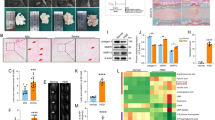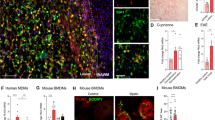Abstract
Acrylamide (ACR), a soft electrophile, is a typical environmental and food contaminant that presents potential health hazards and, consequently, is attracting increasing attention in the quest for its control. ACR neurotoxicity has been widely reported in experimental animals and attributed to neuroinflammation; however, the mechanisms involved therein require clarification. In this study, we used a neuron cell model to investigate the mechanisms of ACR-induced neuroinflammation and pyroptosis. The results showed that ACR treatment induced lytic cell death morphologically under both the canonical pyroptotic pathway (NOD-like receptor protein 3 (NLRP3)-apoptosis-associated speck-like protein containing CARD (ASC)-cysteinyl aspartate specific proteinase 1 (caspase-1)-gasdermin D (GSDMD)-interleukin-1β (IL-1β)/interleukin-18 (IL-18)) and an alternative pyroptotic pathway (cysteinyl aspartate specific proteinase 3 (caspase-3)-gasdermin E (GSDME)-IL-1β/IL-18) in SH-SY5Y cells. Moreover, the lactate dehydrogenase (LDH) production, cytokines release, and lytic cell death induced by ACR were diminished by caspase-1 and -3 inhibitors. Furthermore, the knockdown of caspase-1 by small interfering RNA attenuated ACR-induced lytic cell death, suggesting that canonical pyroptosis (the NLRP3-caspase 1-GSDMD-IL-1β signaling axis) played a primary role in the ACR-induced pyroptosis. Of the two pyroptotic-related pathways, the NLRP3 inflammasome cascade was activated first within the 6-h period of ACR exposure, while the activation of the alternative pyroptotic pathway was delayed. Collectively, these results indicate that ACR mainly induces NLRP3-related neuroinflammation and pyroptosis in SH-SY5Y cells, which is, thus, suggestive of an alternative mechanism for ACR-induced neurotoxicity.








Similar content being viewed by others
Data availability
All data in the current study are available from the corresponding authors upon reasonable request.
Abbreviations
- ACR:
-
Acrylamide
- ASC:
-
Apoptosis-associated speck-like protein containing CARD
- Caspase-1:
-
Cysteinyl aspartate specific proteinase 1
- Caspase-3:
-
Cysteinyl aspartate specific proteinase 3
- DMSO:
-
Dimethyl sulfoxide
- FBS:
-
Fetal bovine serum
- GSDMD:
-
Gasdermin D
- GSDME:
-
Gasdermin E
- GSH:
-
Glutathione
- IL-1β:
-
Interleukin-1β
- IL-18:
-
Interleukin-18
- LDH:
-
Lactate dehydrogenase
- MDA:
-
Malondialdehyde
- MEM:
-
Minimum essential medium
- MTT:
-
3-(4, 5-Dimethyl-2-thiazolyl)-2, 5-diphenyl-2-H-tetrazolium bromide
- NAC:
-
N-acetyl-L-cysteine
- NLRP3:
-
NOD-like receptor protein 3
- ROS:
-
Reactive oxygen species
- TNF-α:
-
Tumor necrosis factor-α
References
Exon JH (2006) A review of the toxicology of acrylamide. J Toxicol Environ Health B Crit Rev 9(5):397–412. https://doi.org/10.1080/10937400600681430
Busova M, Bencko V, VeszelitsLakticova K, Holcatova I, Vargova M (2020) Risk of exposure to acrylamide. Cent Eur J Public Health 28(Suppl):S43–S46. https://doi.org/10.21101/cejph.a6177
Uthra C, Shrivastava S, Jaswal A, Sinha N, Reshi MS, Shukla S (2017) Therapeutic potential of quercetin against acrylamide induced toxicity in rats. Biomed Pharmacother 86:705–714. https://doi.org/10.1016/j.biopha.2016.12.065
An L, Li G, Si J, Zhang C, Han X, Wang S, Jiang L, Xie K (2016) Acrylamide retards the slow axonal transport of neurofilaments in rat cultured dorsal root ganglia neurons and the corresponding mechanisms. Neurochem Res 41(5):1000–1009. https://doi.org/10.1007/s11064-015-1782-z
Mohr S, Stamler JS, Brüne B (1994) Mechanism of covalent modification of glyceraldehyde-3-phosphate dehydrogenase at its active site thiol by nitric oxide, peroxynitrite and related nitrosating agents. FEBS Lett 348(3):223–227. https://doi.org/10.1016/0014-5793(94)00596-6
Murray SM, Waddell BM, Wu CW (2020) Neuron-specific toxicity of chronic acrylamide exposure in C. elegans. Neurotoxicol Teratol 77:106848. https://doi.org/10.1016/j.ntt.2019.106848
Liu Z, Song G, Zou C, Liu G, Wu W, Yuan T, Liu X (2015) Acrylamide induces mitochondrial dysfunction and apoptosis in BV-2 microglial cells. Free Radic Biol Med 84:42–53. https://doi.org/10.1016/j.freeradbiomed.2015.03.013
Lee JG, Wang YS, Chou CC (2014) Acrylamide-induced apoptosis in rat primary astrocytes and human astrocytoma cell lines. Toxicol In Vitro 28(4):562–570. https://doi.org/10.1016/j.tiv.2014.01.005
Henn A, Lund S, Hedtjarn M, Schrattenholz A, Porzgen P, Leist M (2009) The suitability of BV2 cells as alternative model system for primary microglia cultures or for animal experiments examining brain inflammation. ALTEX 26(2):83–94. https://doi.org/10.14573/altex.2009.2.83
Zhao M, Wang FSL, Hu XS, Chen F, Chan HM (2017) Effect of acrylamide-induced neurotoxicity in a primary astrocytes/microglial co-culture model. Toxicol In Vitro 39:119–125. https://doi.org/10.1016/j.tiv.2016.11.007
Zhao M, Wang P, Zhu Y, Liu X, Hu X, Chen F (2015) The chemoprotection of a blueberry anthocyanin extract against the acrylamide-induced oxidative stress in mitochondria: unequivocal evidence in mice liver. Food Funct 6(9):3006–3012. https://doi.org/10.1039/c5fo00408j
Barber DS, LoPachin RM (2004) Proteomic analysis of acrylamide-protein adduct formation in rat brain synaptosomes. Toxicol Appl Pharmacol 201(2):120–136. https://doi.org/10.1016/j.taap.2004.05.008
Santhanasabapathy R, Vasudevan S, Anupriya K, Pabitha R, Sudhandiran G (2015) Farnesol quells oxidative stress, reactive gliosis and inflammation during acrylamide-induced neurotoxicity: behavioral and biochemical evidence. Neuroscience 308:212–227. https://doi.org/10.1016/j.neuroscience.2015.08.067
Yan D, Pan X, Yao J, Wang D, Wu X, Chen X, Shi N, Yan H (2019) MAPKs and NF-kappaB-mediated acrylamide-induced neuropathy in rat striatum and human neuroblastoma cells SY5Y. J Cell Biochem 120(3):3898–3910. https://doi.org/10.1002/jcb.27671
Sui X, Yang J, Zhang G, Yuan X, Li W, Long J, Luo Y, Li Y, Wang Y (2020) NLRP3 inflammasome inhibition attenuates subacute neurotoxicity induced by acrylamide in vitro and in vivo. Toxicology 432:152392. https://doi.org/10.1016/j.tox.2020.152392
Zhao M, Deng L, Lu X, Fan L, Zhu Y, Zhao L (2022) The involvement of oxidative stress, neuronal lesions, neurotransmission impairment, and neuroinflammation in acrylamide-induced neurotoxicity in C57/BL6 mice. Environ Sci Pollut Res Int 29(27):41151–41167. https://doi.org/10.1007/s11356-021-18146-2
Hanamsagar R, Torres V, Kielian T (2011) Inflammasome activation and IL-1beta/IL-18 processing are influenced by distinct pathways in microglia. J Neurochem 119(4):736–748. https://doi.org/10.1111/j.1471-4159.2011.07481.x
Afonina IS, Zhong Z, Karin M, Beyaert R (2017) Limiting inflammation-the negative regulation of NF-kappaB and the NLRP3 inflammasome. Nat Immunol 18(8):861–869. https://doi.org/10.1038/ni.3772
Wu AG, Zhou XG, Qiao G, Yu L, Tang Y, Yan L, Qiu WQ, Pan R, Yu CL, Law BY, Qin DL, Wu JM (2021) Targeting microglial autophagic degradation in NLRP3 inflammasome-mediated neurodegenerative diseases. Ageing Res Rev 65:101202. https://doi.org/10.1016/j.arr.2020.101202
Liu Y, Zhang X, Yan D, Wang Y, Wang N, Liu Y, Tan A, Chen X, Yan H (2020) Chronic acrylamide exposure induced glia cell activation, NLRP3 infl-ammasome upregulation and cognitive impairment. Toxicol Appl Pharmacol 393:114949. https://doi.org/10.1016/j.taap.2020.114949
Peng D, Li J, Deng Y, Zhu X, Zhao L, Zhang Y, Li Z, Ou S, Li S, Jiang Y (2020) Sodium para-aminosalicylic acid inhibits manganese-induced NLRP3 inflammasome-dependent pyroptosis by inhibiting NF-kappaB pathway activation and oxidative stress. J Neuroinflammation 17(1):343. https://doi.org/10.1186/s12974-020-02018-6
Wang Y, Yin B, Li D, Wang G, Han X, Sun X (2018) GSDME mediates caspase-3-dependent pyroptosis in gastric cancer. Biochem Biophys Res Commun 495(1):1418–1425. https://doi.org/10.1016/j.bbrc.2017.11.156
Xia W, Li Y, Wu M, Jin Q, Wang Q, Li S, Huang S, Zhang A, Zhang Y, Jia Z (2021) Gasdermin E deficiency attenuates acute kidney injury by inhibiting pyroptosis and inflammation. Cell Death Dis 12(2):139. https://doi.org/10.1038/s41419-021-03431-2
Alrashidi H, Eaton S, Heales S (2021) Biochemical characterization of proliferative and differentiated SH-SY5Y cell line as a model for Parkinson’s disease. Neurochem Int 145:105009. https://doi.org/10.1016/j.neuint.2021.105009
Deng L, Zhao M, Cui Y, Xia Q, Jiang L, Yin H, Zhao L (2021) Acrylamide induces intrinsic apoptosis and inhibits protective autophagy via the ROS mediated mitochondrial dysfunction pathway in U87-MG cells. Drug Chem Toxicol:1–12. https://doi.org/10.1080/01480545.2021.1979030
Wang Y, Gao W, Shi X, Ding J, Liu W, He H, Wang K, Shao F (2017) Chemotherapy drugs induce pyroptosis through caspase-3 cleavage of a gasdermin. Nature 547(7661):99–103. https://doi.org/10.1038/nature22393
Pei P, Yao X, Jiang L, Qiu T, Wang N, Yang L, Gao N, Wang Z, Yang G, Liu X, Liu S, Jia X, Tao Y, Wei S, Sun X (2019) Inorganic arsenic induces pyroptosis and pancreatic beta cells dysfunction through stimulating the IRE1alpha/TNF-alpha pathway and protective effect of taurine. Food Chem Toxicol 125:392–402. https://doi.org/10.1016/j.fct.2019.01.015
Loboda A, Damulewicz M, Pyza E, Jozkowicz A, Dulak J (2016) Role of Nrf2/HO-1 system in development, oxidative stress response and diseases: an evolutionarily conserved mechanism. Cell Mol Life Sci 73(17):3221–3247. https://doi.org/10.1007/s00018-016-2223-0
Shen X, Wang H, Weng C, Jiang H, Chen J (2021) Caspase 3/GSDME-dependent pyroptosis contributes to chemotherapy drug-induced nephrotoxicity. Cell Death Dis 12(2):186. https://doi.org/10.1038/s41419-021-03458-5
Zong C, Hasegawa R, Urushitani M, Zhang L, Nagashima D, Sakurai T, Ichihara S, Ohsako S, Ichihara G (2019) Role of microglial activation and neuroinflammation in neurotoxicity of acrylamide in vivo and in vitro. Arch Toxicol 93(7):2007–2019. https://doi.org/10.1007/s00204-019-02471-0
Sivandzade F, Cucullo L (2021) Regenerative stem cell therapy for neurodegenerative diseases: an overview. Int J Mol Sci 22(4):2153. https://doi.org/10.3390/ijms22042153
An H, Heo JS, Kim P, Lian Z, Lee S, Park J, Hong E, Pang K, Park Y, Ooshima A, Lee J, Son M, Park H, Wu Z, Park KS, Kim SJ, Bae I, Yang KM (2021) Tetraarsenic hexoxide enhances generation of mitochondrial ROS to promote pyroptosis by inducing the activation of caspase-3/GSDME in triple-negative breast cancer cells. Cell Death Dis 12(2):159. https://doi.org/10.1038/s41419-021-03454-9
Abedpoor N, Taghian F, Hajibabaie F (2022) Cross brain-gut analysis highlighted hub genes and lncRNA networks differentially modified during leucine consumption and endurance exercise in mice with depression-like behaviors. Mol Neurobiol 59(7):4106–4123. https://doi.org/10.1007/s12035-022-02835-1
Funding
This work was supported by the National Natural Science Foundation for Young Scientists of China (No. 31801668), the Shanghai PuJiang Program (18J1401900), and the Shanghai Frontiers Science Center of Optogenetic Techniques for Cell Metabolism (Shanghai Municipal Education Commission).
Author information
Authors and Affiliations
Contributions
Zhao Mengyao: conceptualization, methodology, original draft preparation, writing – review and editing, project administration, funding acquisition.
Zhang Boya: investigation, writing – review and editing.
Deng Linlin: validation, visualization.
Zhao Liming: funding acquisition, project administration, supervision.
All authors read and approved the final manuscript.
Corresponding author
Ethics declarations
Ethics approval
Not applicable.
Consent to participate
Not applicable.
Consent for publication
Not applicable.
Competing interests
The authors declare no competing interests.
Additional information
Publisher's note
Springer Nature remains neutral with regard to jurisdictional claims in published maps and institutional affiliations.
Supplementary Information
Below is the link to the electronic supplementary material.
ESM 1
(DOCX 638 KB)
Rights and permissions
Springer Nature or its licensor (e.g. a society or other partner) holds exclusive rights to this article under a publishing agreement with the author(s) or other rightsholder(s); author self-archiving of the accepted manuscript version of this article is solely governed by the terms of such publishing agreement and applicable law.
About this article
Cite this article
Zhao, M., Zhang, B., Deng, L. et al. Acrylamide Induces Neurotoxicity in SH-SY5Y Cells via NLRP3-mediated Pyroptosis. Mol Neurobiol 60, 596–609 (2023). https://doi.org/10.1007/s12035-022-03098-6
Received:
Accepted:
Published:
Issue Date:
DOI: https://doi.org/10.1007/s12035-022-03098-6




